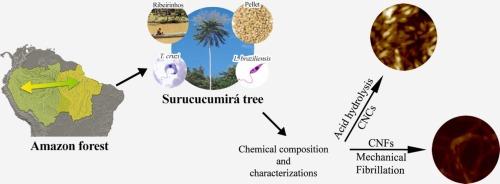亚马逊杉木纤维:从原生树木到可能的可持续纳米增强物。
IF 6.2
1区 农林科学
Q1 AGRICULTURAL ENGINEERING
引用次数: 0
摘要
纤维素纳米晶体(CNCs)和纳米原纤维(CNFs)是从一种叫做suucucumir本文章由计算机程序翻译,如有差异,请以英文原文为准。

Amazonian Surucucumirá fibers: From native tree to a possible sustainable nano-reinforcement.
Cellulose nanocrystals (CNCs) and nanofibrils (CNFs) were obtained from fibers of a native Amazon tree known as Surucucumirá (Spathelia excelsa (Krause) Cowan & Brizicky [sin. Sohnroyia excelsa K.]). The chemical composition of the biomass was inspected through TAPPI standards and the lignin and alphacellulose contents were, respectively, around 38.9 % and 31.3 %. Fourier Transform Infrared Spectroscopy (FTIR) analysis confirmed the successful removal of lignin and hemicellulose from the raw fibers without disrupting the cellulose's glycosidic bonds. This is further supported by the scanning electron microscopy (SEM) micrographs, which reveal the fibrillation following the bleaching process. Thermogravimetry (TG) results showed the dependence of intermolecular and intramolecular interactions influencing on thermal stability, with CNFs exhibiting higher stability compared to CNCs. X-ray diffraction (XRD) analysis revealed a significant increase in crystallinity, with the Crystallinity Index (CI) rising from 54.1 % for the raw samples to 89.6 % for the nanocellulose samples. Atomic force microscopy (AFM) nanographs confirmed the successful extraction of both CNCs and CNFs.
求助全文
通过发布文献求助,成功后即可免费获取论文全文。
去求助
来源期刊

Industrial Crops and Products
农林科学-农业工程
CiteScore
9.50
自引率
8.50%
发文量
1518
审稿时长
43 days
期刊介绍:
Industrial Crops and Products is an International Journal publishing academic and industrial research on industrial (defined as non-food/non-feed) crops and products. Papers concern both crop-oriented and bio-based materials from crops-oriented research, and should be of interest to an international audience, hypothesis driven, and where comparisons are made statistics performed.
 求助内容:
求助内容: 应助结果提醒方式:
应助结果提醒方式:


